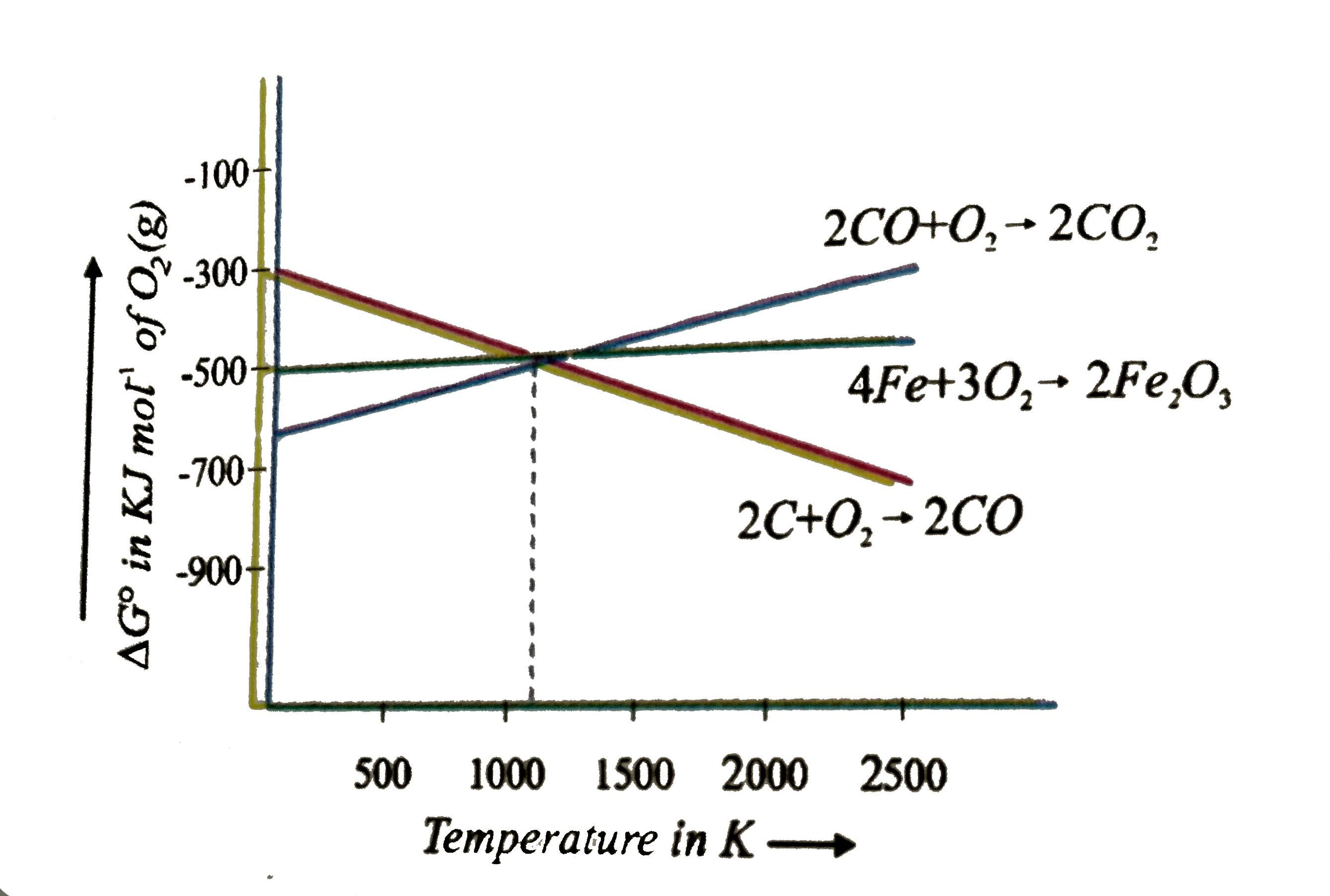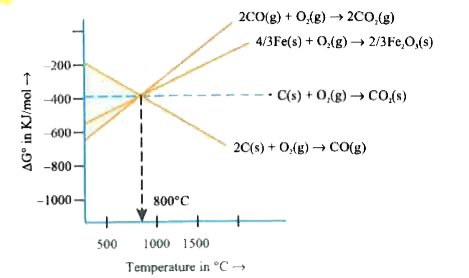A:Carbon is used in blast furnace for reuction of Fe2O3
B:This process is called smelting.
If both Assertion & Reason are true and the reason is the correct explanation of the assertion, then mark (1).
If both Assertion & Reason are true but the reason is not the correct explanation of the assertion, then mark (2)
If Assertion is true statement but Reason is false, then mark
If both Assertion and Reason are false statements, then mark (4)
The correct Answer is:B
Step-by-Step Solution:
1. Understanding the Reaction: The first statement mentions that carbon is used in a blast furnace for the reduction of Fe2O3. Here, Fe2O3 is iron(III) oxide, commonly known as hematite. The reduction process involves converting the oxide into its elemental form, which in this case is iron (Fe).
2. Reduction Process: In the blast furnace, carbon (often in the form of coke) is used as a reducing agent. The carbon reacts with the oxygen in the iron oxide to produce carbon dioxide (CO2) and iron (Fe). The chemical reaction can be represented as:
\(
Fe_2O_3 + 3C \rightarrow 2Fe + 3CO_2
\)
3. Defining Smelting: The second statement asserts that this process is called smelting. Smelting is a metallurgical process that involves the extraction of metals from their ores by heating and melting. In this context, the reduction of iron oxide using carbon is indeed classified as smelting.
4. Conclusion: Both statements A and B are correct. Carbon is used in the blast furnace for the reduction of Fe2O3, and this process is referred to as smelting.
Final Answer:
- A: True - Carbon is used in the blast furnace for the reduction of Fe2O3.
- B: True - This process is called smelting.
---
\(
Fe_2O_3 + 3C \rightarrow 2Fe + 3CO_2
\)
- A: True - Carbon is used in the blast furnace for the reduction of Fe2O3.
- B: True - This process is called smelting.
Topper's Solved these Questions
- GENERAL PRINCIPLES AND PROCESSES OF ISOLATION OF ELEMENTSBook:AAKASH INSTITUTEChapter:GENERAL PRINCIPLES AND PROCESSES OF ISOLATION OF ELEMENTSExercise:Assignment (Section-C) Previous Years Question
Explore 34 Videos
- EQUILIBRIUMBook:AAKASH INSTITUTEChapter:EQUILIBRIUMExercise:ASSIGNMENT (SECTION -D)
Explore 20 Videos
- GENERAL PRINCIPLES AND PROCESSES OF ISOLATION OF ELEMENTSBook:AAKASH INSTITUTEChapter:GENERAL PRINCIPLES AND PROCESSES OF ISOLATION OF ELEMENTSExercise:Try Yourself
Explore 33 Videos
Similar Questions
Correct statements from the graph

I) Above 1073 K,ΔG0 for the formation of F2O3 is less negative than ΔG0 for the formation of CO from carbon
II) Above 1073K, Carbon can reduce Fe2O3
III) Below 1073K, CO can reduce Fe2O3
IV) In blast furnance, reduction of Fe2CO3 occurs in different temperature ranges with below 1073K by CO (or) above 1073 K by carbon
View SolutionReduction of Fe2O3 with CO is done below 710∘C.
ΔfGӨ is negative at this temperature , this process is spontaneous.
View Solution
Knowledge Check
Carbon cannot be used in the reduction of Al2O3 because
Ait is an expensive propositionBthe enthalpy of formation of CO2 is more than that of Al2O3Cpure carbon is not easily availableDthe enthalpy of formation of Al2O3 is too highCorrect statements form the graph

I) Above 1073K, ΔG0 for the formation of Fe2O3 is less negative than ΔG0 for the formation of CO from carbon
II) Above 1073K, Carbon can reduce Fe2O3
III) Below 1073K, CO can reduce Fe2O3
IV) In blast furnace, reduction of Fe2O3 occurs in different temperature ranges with below 1073K by CO (or) above 1073K by carbonAOnly IBI, II onlyCI, II, III onlyDAllDirect reduction of Fe2O3 by Carbon is possible at temperature.
Aless than 1123 KBequal to or less than 1123 KCmore than 1123 KDequal to or more than 1123 K.
Assertion : Zinc is obtained from the roasted or calcined ore (ZnO) by heating with calculated quantity of coal or coke in a reverberatory furnace, when C reduces the metal oxide to free metal.
Reason : The process of extracting the metal by reduction of its oxide ore with carbon is called smelting.
View SolutionExtraction of copper is done using copper pyrites. After roasting, the ore is mixed with silica and coke and then smelted in a blast furnace. The matte obtained from the blast furnace is charged into a silica-lined converter. Some silica is also added, and a hot air blast is blown into the mixture to obtain blister copper, which is purified by electrorefining.
Coke is added during smelting to.
View SolutionExtraction of copper is done using copper pyrites. After roasting, the ore is mixed with silica and coke and then smelted in a blast furnace. The matte obtained from the blast furnace is charged into a silica-lined converter. Some silica is also added, and a hot air blast is blown into the mixture to obtain blister copper, which is purified by electrorefining.
The chemical composition of the slag formed during smelting is.
View SolutionHydrogen can be prepared by mixing steam and water gas at 500∘C in the presence of Fe3O4 and Cr2O3. This process is called
View SolutionExtraction of copper is done using copper pyrites. After roasting, the ore is mixed with silica and coke and then smelted in a blast furnace. The matte obtained from the blast furnace is charged into a silica-lined converter. Some silica is also added, and a hot air blast is blown into the mixture to obtain blister copper, which is purified by electrorefining.
The chemical formula of copper pyrites is.
View Solution